Wehrmacht
| Wehrmacht | |
|---|---|
| Armed Forces of Nazi Germany | |
|
The Wehrmacht's emblem, the straight-armed Balkenkreuz, a stylized version of the Iron Cross | |
| Active | 1935–45[1][N 1] |
| Country |
|
| Allegiance | Adolf Hitler |
| Branch |
Heer (army) Kriegsmarine (navy) Luftwaffe (air force) |
| Role | Armed forces of Nazi Germany |
| Size | 18,200,000 (total who served) |
| Colors | Feldgrau |
| Engagements |
Spanish Civil War World War II |
| Decorations | See List of military decorations of Nazi Germany |
| Commanders | |
| Notable commanders |
Hermann Göring Wilhelm Keitel Alfred Jodl Erich Raeder Karl Dönitz Heinz Guderian Erwin Rommel Erich von Manstein Gerd von Rundstedt |
| Insignia | |
| Identification symbol | Balkenkreuz |
| Identification symbol | Nazi swastika |
The Wehrmacht (German pronunciation: [ˈveːɐ̯maxt], lit. "defence force")[N 2] was the unified armed forces of Nazi Germany from 1935 to 1946. It consisted of the Heer (army), the Kriegsmarine (navy) and the Luftwaffe (air force).[4] The designation Wehrmacht for Nazi Germany's military replaced the previously used term, Reichswehr (1919–35), and was the manifestation of Nazi Germany's efforts to rearm the nation to a greater extent than the Treaty of Versailles permitted.[5]
After the Nazi seizure of power in 1933, one of Adolf Hitler’s most overt and audacious moves was to establish the Wehrmacht, a modern armed force fully capable of offensive use. Fulfilling the Nazi regime’s long-term goals of regaining lost territory and dominating its neighbors required the reinstatement of conscription and massive investment and spending on the armaments industry.[6] In December 1941, Hitler designated himself as commander-in-chief of the Wehrmacht.[7]
The Wehrmacht formed the heart of Germany’s politico-military power. In the early part of World War II, Hitler's generals employed the Wehrmacht through innovative combined arms tactics (close cover air-support, mechanized armor, and infantry) to devastating effect in what was called a Blitzkrieg (lightning war). The Wehrmacht's new military structure, unique combat techniques, newly developed weapons, and unprecedented speed and brutality crushed their opponents.[8]
Closely cooperating with the SS (especially on the Eastern Front), the German armed forces committed numerous war crimes and atrocities, despite later denials.[9] By the time the war ended in Europe in May 1945, the Wehrmacht had lost approximately 11,300,000 men,[10] about half of which were missing or killed during the war. Only a few of the Wehrmacht’s upper leadership were tried for war crimes, despite evidence suggesting that more were involved in illegal actions.[11]
Origin and use of the term
The German term Wehrmacht generically describes any nation's armed forces; for example, Britische Wehrmacht means "British Armed Forces." The Frankfurt Constitution of 1848 designated all German military forces as the "German Wehrmacht", consisting of the Seemacht (sea force) and the Landmacht (land force).[12] In 1919, the term Wehrmacht also appears in Article 47 of the Weimar Constitution, establishing that: "The Reich's President holds supreme command of all armed forces [i.e. the Wehrmacht] of the Reich". From 1919, Germany's national defense force was known as the Reichswehr, a name that was dropped in favor of Wehrmacht on 21 May 1935.[13]
Background
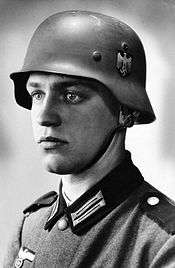
In January 1919, after World War I ended with the signing of the armistice of 11 November 1918, the armed forces were dubbed Friedensheer (peace army).[14] In March 1919, the national assembly passed a law founding a 420,000-strong preliminary army, the Vorläufige Reichswehr. The terms of the Treaty of Versailles were announced in May, and in June, Germany signed the treaty that, among other terms, imposed severe constraints on the size of Germany's armed forces. The army was limited to one hundred thousand men with an additional fifteen thousand in the navy. The fleet was to consist of at most six battleships, six cruisers, and twelve destroyers. Submarines, tanks and heavy artillery were forbidden and the air-force was dissolved. A new post-war military, the Reichswehr, was established on 23 March 1921. General conscription was abolished under another mandate of the Versailles treaty.[15]
The Reichswehr was limited to 115,000 men, and thus the armed forces, under the leadership of Hans von Seeckt, retained only the most capable officers. The American historians Alan Millet and Williamson Murray wrote "In reducing the officers corps, Seeckt chose the new leadership from the best men of the general staff with ruthless disregard for other constituencies, such as war heroes and the nobility".[16] Seeckt's determination that the Reichswehr be an elite cadre force that would serve as the nucleus of an expanded military when the chance for restoring conscription came essentially led to the creation of a new army, based upon, but very different from, the army that existed in World War I.[16] In the 1920s, Seeckt and his officers developed new doctrines that emphasized speed, aggression, combined arms and initiative on the part of lower officers to take advantage of momentary opportunities.[16] Though Seeckt retired in 1926, the army that went to war in 1939 was largely his creation.[17]
Germany was forbidden to have an air-force by the Versailles treaty; nonetheless, Seeckt created a clandestine cadre of air-force officers in the early 1920s. These officers saw the role of an air-force as winning air-superiority, tactical and strategic bombing and providing ground support. That the Luftwaffe did not develop a strategic bombing force in the 1930s was not due to a lack of interest, but because of economic limitations.[18] The leadership of the Navy led by Grand Admiral Erich Raeder, a close protégé of Alfred von Tirpitz, was dedicated to the idea of reviving Tirpitz's High Seas Fleet. Officers who believed in submarine warfare led by Admiral Karl Dönitz were in a minority before 1939.[19]
By 1922, Germany had begun covertly circumventing the conditions of the Versailles Treaty. A secret collaboration with the Soviet Union began after the treaty of Rapallo.[20] Major-General Otto Hasse traveled to Moscow in 1923 to further negotiate the terms. Germany helped the Soviet Union with industrialization and Soviet officers were to be trained in Germany. German tank and air-force specialists could exercise in the Soviet Union and German chemical weapons research and manufacture would be carried out there along with other projects.[21] In 1924 a training base was established at Lipetsk in central Russia, where several hundred German air force personnel received instruction in operational maintenance, navigation, and aerial combat training over the next decade until the Germans finally left in September 1933.[22]
Nazi rise to power
After the death of President Paul von Hindenburg on 2 August 1934, Adolf Hitler assumed the office of President of Germany, and thus became commander in chief. In February 1934, the Defence Minister Werner von Blomberg, acting on his own initiative, had all of the Jews serving in the Reichswehr given an automatic and immediate dishonorable discharge.[23] Again, on his own initiative Blomberg had the armed forces adopt Nazi symbols into their uniforms in May 1934.[24] In August of the same year, on Blomberg's initiative and that of the Ministeramt chief General Walther von Reichenau, the entire military took the Hitler oath, an oath of personal loyalty to Hitler. Hitler was most surprised at the offer; the popular view that Hitler imposed the oath on the military is false.[25] The oath read: "I swear by God this sacred oath that to the Leader of the German empire and people, Adolf Hitler, supreme commander of the armed forces, I shall render unconditional obedience and that as a brave soldier I shall at all times be prepared to give my life for this oath".[26]
By 1935, Germany was openly flouting the military restrictions set forth in the Versailles Treaty: German re-armament was announced on 16 March as was the reintroduction of conscription.[27] While the size of the standing army was to remain at about the 100,000-man mark decreed by the treaty, a new group of conscripts equal to this size would receive training each year. The conscription law introduced the name "Wehrmacht"; the Reichswehr was officially renamed the Wehrmacht on 21 May 1935.[28] Hitler’s proclamation of the Wehrmacht's existence included a total of no less than 36 divisions in its original projection, contravening the Treaty of Versailles in grandiose fashion. In December 1935, General Ludwig Beck added 48 tank battalions to the planned rearmament program.[29]
Wehrmacht's armaments received a large boost as a consequence of occupation of Czechoslovakia. In a speech delivered in the Reichstag, Hitler stressed that by occupying Czechoslovakia, Germany gained 2,175 field cannons, 469 tanks, 500 anti-aircraft artillery pieces, 43,000 machine guns, 1,090,000 military rifles, 114,000 pistols, about a billion rounds of ammunition and three million anti-aircraft rounds. This amount of weaponry would be sufficient to arm about half of the then Wehrmacht.[30]
Personnel and recruitment
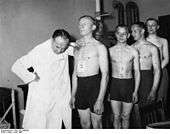
The total number of soldiers who served in the Wehrmacht during its existence from 1935 to 1945 is believed to have approached 18.2 million.[31] The Wehrmacht lost about 10,000,000 soldiers during the period from 1939-1945, a combination of about 2,000,000 KIA, 3,000,000 MIA, and 5,000,000 WIA.[32] Recruitment for the Wehrmacht was accomplished through voluntary enlistment (1933–45) and conscription (1935–45). As World War II intensified, Naval and Luftwaffe personnel were increasingly transferred to the Army, and "voluntary" enlistments in the SS were stepped up as well. Following the Battle of Stalingrad in 1943, fitness standards for Wehrmacht recruits were drastically lowered, with the regime going so far as to create "special diet" battalions for men with severe stomach ailments. Rear-echelon personnel were sent to front-line duty wherever possible, especially during the last two years of the war.[32]
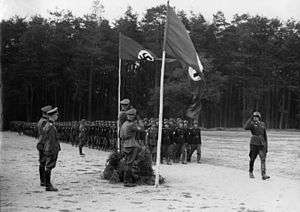
Prior to World War II, the Wehrmacht strove to remain a purely German force; as such, minorities, such as the Czechs in annexed Czechoslovakia, were exempted from military service after Hitler's takeover in 1938. Foreign volunteers were generally not accepted in the German armed forces prior to 1941. With the invasion of the Soviet Union in 1941, the government's positions changed. German propagandists wanted to present the war not as a purely German concern, but as a multi-national crusade against the so-called Jewish Bolshevism. Hence, the Wehrmacht and SS began to seek out recruits from occupied and neutral countries across Europe: the Germanic populations of the Netherlands and Norway were recruited largely into the SS, while "non-Germanic" people were recruited into the Wehrmacht. The "voluntary" nature of such recruitment was often dubious, especially in the later years of the war, when even Poles living in the Polish Corridor were declared "ethnic Germans" and drafted.[32]
After Germany's defeat in the Battle of Stalingrad, the Wehrmacht also made substantial use of personnel from the Soviet Union, including the Caucasian Muslim Legion, Turkestan legion, Crimean Tatars, ethnic Ukrainians and Russians, Cossacks, and others who wished to fight against the Soviet regime or who were otherwise induced to join.[32] A few thousand White émigrés joined the ranks of the Wehrmacht and Waffen-SS, often acting as interpreters.[33]
Command structure
Legally, the Commander-in-Chief of the Wehrmacht was Adolf Hitler in his capacity as Germany's head of state, a position he gained after the death of President Paul von Hindenburg in August 1934. In the reshuffle in 1938, Hitler became the Supreme Commander of the Armed Forces and retained that position until his suicide on 30 April 1945.[34] Administration and military authority initially lay with the war ministry under Field Marshal Werner von Blomberg. After Blomberg resigned in the course of the 1938 Blomberg-Fritsch Affair, the ministry was dissolved and the Armed Forces High Command (Oberkommando der Wehrmacht or OKW) under Field Marshal Wilhelm Keitel was put in its place.[35] Army work was also coordinated by the German General Staff.
The OKW coordinated all military activities but Keitel's sway over the three branches of service (army, air force, and navy) was limited. Each had its own High Command, known as Oberkommando des Heeres (OKH, army), Oberkommando der Marine (OKM, navy), and Oberkommando der Luftwaffe (OKL, air force). Each of these high commands had its own general staff. In practice the OKW had operational authority over the Western Front whereas the Eastern Front was under the operational authority of the OKH.
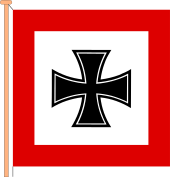
- Supreme High Command of the Armed Forces (OKW)
- Supreme Commander of the Armed Forces
- Führer and Chancellor of Germany Adolf Hitler (1935–1945)
- Großadmiral Karl Dönitz (1945)
- Commander-in-chief of the Armed Forces
- Field Marshal Paul von Hindenburg (1933–1934), President of the Reich
- Adolf Hitler (1934–1935)
- Field Marschal Werner von Blomberg (1935–1938)[36]
- Vice Commander-in-chief of the Armed Forces
- Generaloberst Werner von Blomberg (1933–1935)
- Chief of the Armed Forces Supreme High Command—Field Marshal Wilhelm Keitel (1938–1945)
- Chief of the Operations Staff —Generaloberst Alfred Jodl
- Supreme Commander of the Armed Forces
- Supreme High Command of the Army (OKH)
- Army Commanders-in-Chief
- Generaloberst Werner von Fritsch (1935–1938)[37]
- Field Marshal Walther von Brauchitsch (1938–1941)[38]
- Adolf Hitler (1941–1945)
- Field Marshal Ferdinand Schörner (1945)
- Chiefs of Staff of the German Army
- General Ludwig Beck (1935–1938)
- General Franz Halder (1938–1942)
- General Kurt Zeitzler (1942–1944)
- Generaloberst Heinz Guderian (1944–1945)
- General Hans Krebs (Wehrmacht general April - May 1945; committed suicide in the Führerbunker)
- Army Commanders-in-Chief
- Supreme High Command of the Navy (OKM)
- War Navy Commanders-in-Chief
- Grand Admiral Erich Raeder (1928–1943)
- Grand Admiral Karl Dönitz (1943–1945)
- Admiral Hans-Georg von Friedeburg (1945)
- War Navy Commanders-in-Chief
- Supreme High Command of the Air-Force (OKL)
- Air-Force Commanders-in-Chief
- Reichsmarschall Hermann Göring (1935–1945)
- Field Marshal Robert Ritter von Greim (1945)
- Air-Force Commanders-in-Chief
The OKW was also given the task of central economic planning and procurement, but the authority and influence of the OKW's war economy office was challenged by the procurement offices of the single branches of service as well as by the Ministry for Armament and Munitions, into which it was merged after the ministry was taken over by Albert Speer in early 1942.
War years
Army
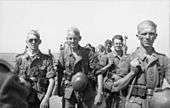
The German Army furthered concepts pioneered during World War I, combining ground (Heer) and Air-Force (Luftwaffe) assets into combined arms teams.[39] Coupled with traditional war fighting methods such as encirclements and the "battle of annihilation", the German military managed many lightning quick victories in the first year of World War II, prompting foreign journalists to create a new word for what they witnessed: Blitzkrieg. Germany's immediate military success on the field at the start of the Second World War coincides the favorable beginning they achieved during the First World War, a fact which some attribute to their superior officer corps.[40]
The Heer entered the war with a minority of its formations motorized; infantry remained approximately 90% foot-borne throughout the war, and artillery was primarily horse-drawn. The motorized formations received much attention in the world press in the opening years of the war, and were cited as the reason for the success of the invasions of Poland (September 1939), Norway and Denmark (April 1940), Belgium, France, and Netherlands (May 1940), Yugoslavia and Greece (April 1941) and the early stage of Operation Barbarossa in the Soviet Union (June 1941).
After Hitler declared war on the United States in December 1941, the Axis powers found themselves engaged in campaigns against several major industrial powers while Germany was still in transition to a war economy. German units were then overextended, undersupplied, outmaneuvered, outnumbered and defeated by its enemies in decisive battles during 1941, 1942, and 1943 at Battle of Moscow, Siege of Leningrad, Stalingrad, Tunis in North Africa, and Battle of Kursk.

The Germans' army military was managed through mission-based tactics (rather than order-based tactics) which was intended to give commanders greater freedom to act on events and exploit opportunities. In public opinion, the German Army was, and sometimes still is, seen as a high-tech army. However, such modern equipment, while featured much in propaganda, was often only available in relatively small numbers. This was primarily because the country was not run as a war economy until 1942–1943. Only 40% to 60% of all units in the Eastern Front were motorized, baggage trains often relied on horse-drawn trailers due to poor roads and weather conditions in the Soviet Union, and for the same reasons many soldiers marched on foot or used bicycles as bicycle infantry. As the fortunes of war turned against them, the Germans were in constant retreat from 1943 and onward. Other Axis powers fought with them, especially Hungary and Romania, as well as many volunteers from other nations.
The Panzer Divisions were vital to the German army's early success. In Hitler's "Blitzkrieg", the German army used tactics that combined both the air force and the ground forces to quickly sweep through Europe. During his time in World War I, Hitler had spent a large portion of the war fighting on a relatively static battleground where both sides gained and lost very little ground. However, in the strategies of the Blitzkrieg, the Wehrmacht combined the mobility of light tanks with airborne assault to quickly progress through weak enemy lines, enabling the German army to quickly and brutally take over Poland and France.[41] These tanks were used to break through enemy lines, isolating regiments from the main force so that the infantry behind the tanks could quickly kill or capture the enemy troops.[42] The effectiveness of the German tank divisions can also be attributed to the training of the Tank crews which lasted about 12–16 weeks of basic training as compared to the 8 and 6 weeks that the Soviet, British and American tank crews were trained for.[43]
Air Force

The Luftwaffe (German Air Force), led by Hermann Göring, was a key element in the early blitzkrieg campaigns (Poland, France 1940, USSR 1941). The Luftwaffe concentrated production on fighters and (small) tactical bombers, like the Messerschmitt Bf 109 fighter and the Junkers Ju 87 (Stuka) dive bomber.[44]
The planes cooperated closely with the ground forces. Overwhelming numbers of fighters assured air-supremacy, and the bombers would attack command- and supply-lines, depots, and other support targets close to the front. As the war progressed, Germany's opponents drastically increased their aircraft production and quality, improved pilot training, and gradually gained air-superiority. As the Western Allies started a strategic bombing campaign against German industrial targets, they established air supremacy over Germany deliberately forcing the Luftwaffe into a war of attrition, denying support to German forces on the ground.
Navy
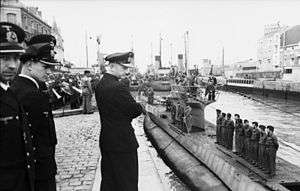
The Kriegsmarine (navy) played a major role in World War II as control over the commerce routes in the Atlantic was crucial for Germany, Britain and later the Soviet Union. In the Battle of the Atlantic, the initially successful German U-boat fleet arm was eventually defeated due to Allied technological innovations like sonar, radar, and the breaking of the Enigma code. Large surface vessels were few in number due to construction limitations by international treaties prior to 1935. The "pocket battleships" Admiral Graf Spee and Admiral Scheer were important as commerce raiders only in the opening year of the war. No aircraft carrier was operational, as German leadership lost interest in the Graf Zeppelin which had been launched in 1938. Following the loss of the German battleship Bismarck in 1941, with Allied air-superiority threatening the remaining battlecruisers in French Atlantic harbors, the ships were ordered to make the Channel Dash back to German ports. Operating from fjords of Norway, which had been occupied in 1940, convoys from North America to the Soviet port of Murmansk could be intercepted though the Tirpitz spent most of her career as fleet in being. After the appointment of Karl Dönitz as Grand Admiral of the Kriegsmarine (in the aftermath of the Battle of the Barents Sea), Germany stopped constructing battleships and cruisers in favor of U-boats.[45]
U-boats were one of Germany's greatest weapon against the Allies at sea which were employed to strike at Allied Convoys. The German naval strategy was to attack the convoys in an attempt to starve Britain of supplies which would disable the ability of the British army to continue fighting the war. Karl Doenitz, the U-Boat Chief, began unrestricted submarine warfare which cost the Allies 22,898 men and 1,315 ships.[46] The U-boat war remained costly for the Allies until early spring of 1943 when the Allies began to use countermeasures against U-Boats such as the use of Hunter-Killer groups, airborne radar, mines and torpedoes like the FIDO.[47]
Coexistence with Waffen-SS
The Waffen-SS, the combat branch of the SS (the Nazi Party's paramilitary organization), became a significant fighting force of Nazi Germany as it expanded from three regiments to 38 divisions by 1945. Although the SS was autonomous and existed in parallel to the Wehrmacht, the Waffen-SS field units were placed under the operational control of the Supreme High Command of the Armed Forces (the OKW) or the Supreme High Command of the Army (the OKH). Interservice rivalry hampered organization in the German armed forces, as the OKW, OKH, OKL and the Waffen-SS often worked concurrently and not as a joint command.
Theatres and campaigns
The Wehrmacht directed combat operations during World War II (from 1 September 1939 – 8 May 1945) as the German Reich's Armed Forces umbrella command organization. After 1941 the OKH became the de facto Eastern Theatre higher echelon command organization for the Wehrmacht, excluding Waffen-SS except for operational and tactical combat purposes. The OKW conducted operations in the Western Theatre. The operations by the Kriegsmarine in the North and Mid-Atlantic can also be considered as separate theatres considering the size of the area of operations and their remoteness from other theatres.
Wehrmacht fought on other fronts, sometimes three simultaneously; redeploying troops from the intensifying theatre in the East to the West after D-Day created tensions between the General Staff of both the OKW and the OKH as Germany lacked sufficient materiel and manpower for a two-front war of such magnitude.[48]
Eastern theatre
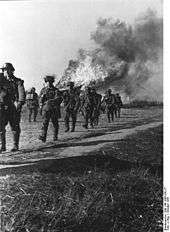
The Eastern Wehrmacht campaigns included:
- Czechoslovakian campaign (1938–1945)
- Austrian Anschluss campaign (1938)
- Battle of Poland campaign (Fall Weiss)
- Balkans and Greece (Operation Marita) (1940–1941)
- Operation Barbarossa (1941), conducted by Army Group North, Army Group Centre, and Army Group South
- Battle of Stalingrad (1942–1943)
- Battle of the Caucasus (1942-1944)
- Battle of Kursk (Operation Citadel) (1943)
- Part of the Eastern Front involved anti-partisan operations against Soviet partisan units and counter-insurgency operations – largely carried out by security divisions of the Wehrmacht and Waffen-SS units in the occupied territories behind Axis front lines.
Western theatre

- Phony War (Sitzkrieg).
- The Denmark campaign as Operation Weserübung
- The Norwegian Campaign
- Combined Western campaign (1940): Battle of the Netherlands and Battle of France (Fall Gelb) in 1940.
- Battle of Britain (1940)
- Battle of the Atlantic
- Battle of Normandy (1944)
- Ardennes Offensive (1944–1945)
- Defense of the Reich air campaign
Mediterranean theatre
For a time, the Axis Mediterranean Theatre and the North African Campaign was conducted as a joint campaign with the Italian Army, and may be considered a separate theatre.
- North African Campaign in Libya, Tunisia and Egypt between the UK and Commonwealth (and later, U.S.) forces and the Axis forces.
- The Italian "Theatre" (1943–45) was a continuation of the Axis defeat in North Africa, and was a Campaign for defence of Italy.
Casualties
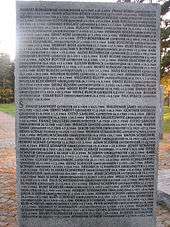
More than 6,000,000 soldiers were wounded during the conflict, while more than 11,000,000 became prisoners. In all, approximately 5,318,000 soldiers from Germany and other nationalities fighting for the German armed forces—including the Waffen-SS—are estimated to have been killed in action, died of wounds, died in custody or gone missing in World War II. Included in this number are 215,000 Soviet citizens conscripted by Germany.[49]
According to Frank Biess,
German casualties took a sudden jump with the defeat of the Sixth Army at Stalingrad in January 1943, when 180,310 soldiers were killed in one month. Among the 5.3 million Wehrmacht casualties during the Second World War, more than 80 percent died during the last two years of the war. Approximately three-quarters of these losses occurred on the Eastern front (2.7 million) and during the final stages of the war between January and May 1945 (1.2 million).[50]
Jeffrey Herf wrote that:
Whereas German deaths between 1941 and 1943 on the western front had not exceeded 3 percent of the total from all fronts, in 1944 the figure jumped to about 14 percent. Yet even in the months following D-day, about 68.5 percent of all German battlefield deaths occurred on the eastern front, as a Soviet blitzkrieg in response devastated the retreating Wehrmacht.[51]
War crimes
Nazi propaganda had told Wehrmacht soldiers to wipe out what were variously called Jewish Bolshevik subhumans, the Mongol hordes, the Asiatic flood and the red beast.[52] While the principal perpetrators of the civil suppression behind the front lines amongst German armed forces were the Nazi German "political" armies (the SS-Totenkopfverbände, the Waffen-SS, and particularly the Einsatzgruppen, the paramilitary death squads of Nazi Germany that were responsible for mass killings, primarily by shooting and the implementation of the so-called Final Solution of the Jewish Question in territories occupied by Nazi Germany), the traditional armed forces represented by the Wehrmacht committed and ordered (e.g. the Commissar Order) war crimes of their own, particularly during the invasion of Poland in 1939[53] and later in the war against the Soviet Union.
Cooperation with the SS
The Army's Chief of Staff General Franz Halder in a directive declared that in the event of guerrilla attacks, German troops were to impose "collective measures of force" by massacring entire villages.[54] Cooperation between the SS Einsatzgruppen and the Wehrmacht involved supplying the killing squads with weapons, ammunition, equipment, transport, and even housing. Partisan fighters, Jews, and Communists became synonymous enemies of the Nazi regime and were hunted down and exterminated by the Einsatzgruppen and Wehrmacht alike, something revealed in numerous field journal entries from German soldiers.[55] Hundreds of thousands, perhaps millions, of Soviet civilians died from starvation as the Germans requisitioned food for their armies and fodder for their draft horses.[56] According to Thomas Kühne, "An estimated 300,000–500,000 people were killed during the Wehrmacht's anti-partisan war in the Soviet Union."[57]
While secretly listening to conversations of captured German generals, British officials became aware that the German army had taken part in the atrocities and mass killing of Jews and were guilty of war crimes.[58] American officials learned of Wehrmacht atrocities in much the same way. Taped conversations of soldiers detained as POWs revealed how some of them voluntarily participated in mass executions.[59]
Crimes against civilians
The Kragujevac massacre was the mass murder of 2,778–2,794 mostly Serb men and boys in the city of Kragujevac by German soldiers on 21 October 1941. It occurred in the German-occupied territory of Serbia during World War II, and came in reprisal for insurgent attacks in the Gornji Milanovac district that resulted in the deaths of 10 German soldiers and the wounding of 26 others. The number of hostages to be shot was calculated based on a ratio of 100 hostages executed for every German soldier killed and 50 hostages executed for every German soldier wounded. After a punitive operation was conducted in the surrounding villages, during which 422 males were shot and four villages burned down, another 70 male Jews and communists who had been arrested in Kragujevac were shot. Simultaneously, males between the ages of 16 and 60, including high school students, were assembled by German troops and local collaborators, and the victims were selected from amongst them. The selected males were then marched to fields outside the city, shot with heavy machine guns, and their bodies buried in mass graves.
Crimes against POWs
While the Wehrmacht's prisoner-of-war camps for inmates from the west generally satisfied the humanitarian requirement prescribed by international law, prisoners from Poland (which never capitulated) and the USSR were incarcerated under significantly worse conditions. Between the launching of Operation Barbarossa in the summer of 1941 and the following spring, 2.8 million of the 3.2 million Soviet prisoners taken died while in German hands.[60]
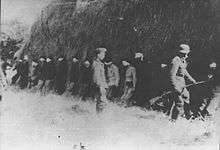
Nuremberg and subsequent trials
The Nuremberg Trials of the major war criminals at the end of World War II found that the Wehrmacht was not an inherently criminal organization, but that it had committed crimes in the course of the war. Several high-ranked members of the Wehrmacht like Wilhelm Keitel and Alfred Jodl were convicted for their involvement in war crimes. Among German historians, the view that the Wehrmacht had participated in war time atrocities, particularly on the Eastern Front, grew in the late 1970s and the 1980s. In the 1990s, public conception in Germany was influenced by controversial reactions and debates about the exhibition of war crime issues.[61]
More recently, the judgement of Nuremberg has come under question. The Israeli historian Omer Bartov, a leading expert on the Wehrmacht[62] wrote in 2003 that the Wehrmacht was a willing instrument of genocide, and that it is untrue that the Wehrmacht was an apolitical, professional fighting force that had only a few "bad apples".[63] Bartov argues that far from being the "untarnished shield", as successive German apologists stated after the war, the Wehrmacht was a criminal organization.[64] Likewise, the British historian Richard J. Evans, a leading expert on modern German history, wrote that the Wehrmacht was a genocidal organization.[52] Historian Ben Shepherd writes that "There is now clear agreement amongst historians that the German Wehrmacht... identified strongly with National Socialism and embroiled itself in the criminality of the Third Reich."[65] British historian Ian Kershaw concludes that the Wehrmacht's duty was to ensure the people who met Hitler's requirements of being part of the Aryan Herrenvolk ("Aryan master race") living space, he wrote that:
The Nazi revolution was broader than just the Holocaust. Its second goal was to eliminate Slavs from central and eastern Europe and to create a Lebensraum for Aryans. ... As Bartov (The Eastern Front; Hitler's Army) shows, it barbarised the German armies on the eastern front. Most of their three million men, from generals to ordinary soldiers, helped exterminate captured Slav soldiers and civilians. This was sometimes cold and deliberate murder of individuals (as with Jews), sometimes generalised brutality and neglect. ... German soldiers' letters and memoirs reveal their terrible reasoning: Slavs were 'the Asiatic-Bolshevik' horde, an inferior but threatening race. Only a minority of officers and men were Nazi members.[66]
Several high-ranking Wehrmacht officers, including Hermann Hoth, Georg von Küchler, Georg-Hans Reinhardt, Karl von Roques, Walter Warlimont and others, were convicted of war crimes and crimes against humanity in the High Command Trial given sentences ranging from time served to life.[67]
Resistance to the Nazi regime
There were several attempts by resistance members within the military like Henning von Tresckow, Erich Hoepner or Friedrich Olbricht to assassinate Adolf Hitler as an ignition of a coup d'état, culminating in the 20 July plot (1944), when a group of officers led by Claus von Stauffenberg tried to assassinate Hitler. German military personnel were ordered to replace the standard military salute with the Hitler salute from this date on.
Some members of the Wehrmacht did save Jews and non-Jews from the concentration camps and/or mass-executions. Anton Schmid —a sergeant in the army— helped 250 Jewish men, women, and children escape from the Vilnius ghetto and provided them with forged passports so that they could get to safety. He was court-martialed and executed as a consequence. Albert Battel, a reserve officer stationed near the Przemysl ghetto, blocked an SS detachment from entering it. He then evacuated up to 100 Jews and their families to the barracks of the local military command, and placed them under his protection. Wilm Hosenfeld—an army captain in Warsaw—helped, hid, or rescued several Poles, including Jews, in occupied Poland. He helped the Polish Jewish composer Władysław Szpilman, who was hiding among the city's ruins, by supplying him with food and water.
Top ranks
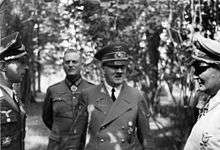
- Reichsmarschall: The post of the Reichsmarschall was the highest military ranking that a German soldier could reach. The post was held solely by Hermann Göring (9 July 1940), the most powerful Nazi leader in Germany next to Hitler, who designated him as his successor on 29 June 1941.[68] Göring also served as the head of the Luftwaffe and was responsible for handling Germany's war economy.[69]
- Generalfeldmarschall: In 1936, Hitler revived the rank of field marshal, originally only for the Minister of War and Commander-in-chief of the Wehrmacht. Most of Germany's field marshals were promoted during the 1940 Field Marshal Ceremony; see List of German field marshals#Nazi Germany (1933–45) for the full listing.
- Generaloberst: The rank of Generaloberst, usually translated as "colonel general", was equivalent to a four-star rank.
- General: This three-star rank was formally linked to the branch of the army or air-force, in which the officer served, such as General of the Infantry, General of the Artillery and General of Armoured Troops (Panzertruppe).
- Generalleutnant: The German Generalleutnant two-star rank was usually a division commander.
- Generalmajor: The German "Generalmajor" one-star rank was usually a brigade commander.
After World War II
Following the unconditional surrender of the Wehrmacht, which went into effect on 8 May 1945, some Wehrmacht units remained active, either independently (e.g. in Norway), or under Allied command as police forces.[70] The last Wehrmacht unit to come under Allied control was an isolated weather station in Svalbard, which formally surrendered to a Norwegian relief ship on 4 September.[71]
On 20 September 1945, with Proclamation No. 2 of the Allied Control Council (ACC), "[a]ll German land, naval and air forces, the S.S., S.A., S.D. and Gestapo, with all their organizations, staffs and institution, including the General Staff, the Officers' corps, the Reserve Corps, military schools, war veterans' organizations, and all other military and quasi-military organizations, together with all clubs and associations which serve to keep alive the military tradition in Germany, shall be completely and finally abolished in accordance with the methods and procedures to be laid down by the Allied Representatives."[72] The Wehrmacht was officially dissolved by the ACC Law 34 on 20 August 1946,[73] which proclaimed the OKW, OKH, the Ministry of Aviation and the OKM to be "disbanded, completely liquidated and declared illegal".[74]
In the mid-1950s, tensions of the Cold War led to the creation of separate military forces in the Federal Republic of Germany and the socialist German Democratic Republic. The West German military, officially created on 5 May 1955, took the name Bundeswehr, meaning Federal Defence Forces. Its East German counterpart—created on 1 March 1956—took the name National People's Army (Nationale Volksarmee). Both organizations employed many former Wehrmacht members, particularly in their formative years, though neither organization considered themselves to be successors to the Wehrmacht.
Gallery
 German Military Medic providing first aid to a wounded soldier in France, June 1940
German Military Medic providing first aid to a wounded soldier in France, June 1940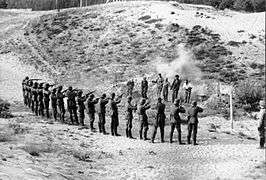 Execution of alleged partisans by German soldiers, Soviet Union, September 1941
Execution of alleged partisans by German soldiers, Soviet Union, September 1941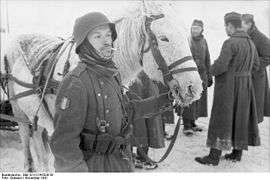 Soviet Union, November 1941
Soviet Union, November 1941 Soviet Union, June 1942
Soviet Union, June 1942 Soldiers of Soviet Central Asian backgrounds in the Ostlegionen of the Wehrmacht.
Soldiers of Soviet Central Asian backgrounds in the Ostlegionen of the Wehrmacht.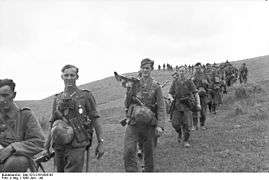 German infantry marching, Soviet Union, June 1943
German infantry marching, Soviet Union, June 1943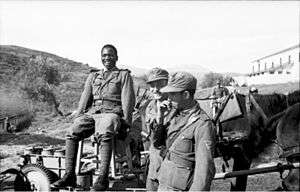 Foreign volunteer battalion in the Wehrmacht. Soldiers of the Free Arabian Legion in Greece, September 1943.
Foreign volunteer battalion in the Wehrmacht. Soldiers of the Free Arabian Legion in Greece, September 1943.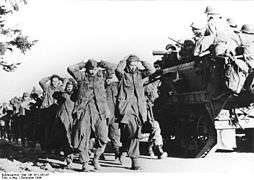 German prisoners march to rear as Americans move forward, December 1944
German prisoners march to rear as Americans move forward, December 1944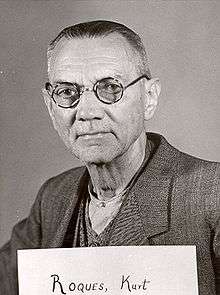 Karl von Roques as defendant at the High Command Trial, 1947
Karl von Roques as defendant at the High Command Trial, 1947_(Wehrmacht)_1.png) Tactical signs of the Wehrmacht
Tactical signs of the Wehrmacht
See also
Notes
- ↑ The official dissolution of the Wehrmacht began with the German Instrument of Surrender of 8 May 1945. Reasserted in Proclamation No. 2 of the Allied Control Council on 20 September 1945 the dissolution was officially declared by ACC Law No. 34 of 20 August 1946.[2][3]
- ↑ From German: wehren, "to defend" and Macht, "power, force". See the Wiktionary article for more information.
References
- ↑ Müller 2016, p. 1.
- ↑ "Enactments and Approved Papers of the Control Council and Coordinating Committee Germany For Year 1945" (PDF). Retrieved 2015-01-26.
- ↑ "Enactments and Approved Papers of the Control Council and Coordinating Committee Germany For Year 1945" (PDF). Retrieved 2015-01-26.
- ↑ Die Verfassungen in Deutschland [German Constitution] online. Reichsgesetzblatt (RGB). RGB1 1935, I, no. 52, p. 609 See: http://www.verfassungen.de/de/de33-45/wehrmachtaufbau35.htm
- ↑ Taylor, Telford. Sword and Swastika: Generals and Nazis in the Third Reich, pp. 90–119.
- ↑ See: "The Economics of Warfare: from Blitzkrieg to Total War," in Kitchen, Martin (1994). Nazi Germany at War, pp. 39–65.
- ↑ Williamson, David G. (2002). The Third Reich, p. 178.
- ↑ Palmer, Michael (2010). The German Wars: A Concise History, 1859–1945, pp. 169–175.
- ↑ Hartmann 2013, pp. 85–108.
- ↑ Fritz 2011, p. 470.
- ↑ See: "The Legend of the Wehrmacht’s Clean Hands," in Wette, Wolfram (2007). The Wehrmacht: History, Myth, Reality, pp. 195–250.
- ↑ "Verfassung des Deutschen Reiches (Paulskirchenverfassung 1848)".
- ↑ Strohn, Matthias (November 2010). The German Army and the Defence of the Reich. Cambridge University Press. p. 10. ISBN 9780521191999. Retrieved 15 May 2015.
- ↑ Wheeler-Bennett, John (1954). The Nemesis of Power: The German Army in Politics, 1918–1945, p. 60
- ↑ Craig, Gordon (1980). Germany, 1866–1945, pp. 424–432.
- 1 2 3 Murray & Millett 2001, p. 22.
- ↑ Wheeler-Bennett, John The Nemesis of Power, page 22.
- ↑ Murray & Millett 2001, p. 33.
- ↑ Murray & Millett 2001, p. 37.
- ↑ Wheeler-Bennett, John W. (1954). The Nemesis of Power: The German Army in Politics, 1918–1945, p. 131.
- ↑ Manfred Zeidler, "The Strange Allies — Red Army and Reichswehr in the Inter-War Period," in Schlögel (2006) Russian-German Special Relations in the Twentieth Century: A Closed Chapter?, pp. 106–111.
- ↑ Cooper, Matthew (1981). The German Air Force, 1933–1945: An Anatomy of Failure, pp. 382–383.
- ↑ Förster 1998, p. 268.
- ↑ Wheeler-Bennett, p. 312.
- ↑ Kershaw, Ian Hitler Hubris, New York: W.W. Norton, 1998 page 525.
- ↑ Buchheim, Broszat, Jacobsen & Krausnick (1967). Anatomie des SS-Staates, p. 18.
- ↑ Fischer, Klaus (1995). Nazi Germany: A New History, p. 408.
- ↑ Stone, David J. (2006) Fighting for the Fatherland: The Story of the German Soldier from 1648 to the Present Day, p. 316.
- ↑ Tooze, Adam (2006). The Wages of Destruction: The Making and Breaking of the Nazi Economy, p. 208.
- ↑ Motl 2007.
- ↑ "Statistics and Numbers". www.feldgrau.com. Retrieved 16 May 2015.
- 1 2 3 4 Handbook on German Military Forces, U.S. War Department Technical Manual TM-E-431, 15 March 1945, Chapter 1: The German Military System.
- ↑ Oleg Beyda, «'Iron Cross of the Wrangel's Army': Russian Emigrants as Interpreters in the Wehrmacht.» Journal of Slavic Military Studies 27, no. 3 (2014): 433.
- ↑ Broszat, Martin (1985)[1969]. The Hitler State: The Foundation and Development of the Internal Structure of the Third Reich, p. 295.
- ↑ Megargee 2000, pp. 41–42.
- ↑ Megargee 2000, pp. 18, 42.
- ↑ Megargee 2000, pp. 20, 42.
- ↑ Megargee 2000, pp. 42.
- ↑ Palmer, Michael A. The German Wars: A Concise History, 1859–1945, pp. 96–97.
- ↑ Mosier, John (2006). Cross of Iron: The Rise and Fall of the German War Machine, 1918–1945, pp. 11–24.
- ↑ "Blitzkrieg". www.historylearningsite.co.uk. Retrieved 20 May 2015.
- ↑ "Germans invade Poland - Sep 01, 1939 - HISTORY.com". Retrieved 21 May 2015.
- ↑ "Training in WWII - The Dupuy Institute Forum". www.dupuyinstitute.org. Retrieved 21 May 2015.
- ↑ Tooze, Adam (2006). The Wages of Destruction: The Making and Breaking of the Nazi Economy, pp. 125–130.
- ↑ Trueman, Chris (2014). "The Battle of Barents Sea". www.historylearningsite.co.uk. HistoryLearningSite. Retrieved 13 May 2015.
- ↑ "Battle of the Atlantic Statistics". www.usmm.org. Retrieved 20 May 2015.
- ↑ "Keeping the Sea Lanes Open: Battle of the Atlantic". Retrieved 20 May 2015.
- ↑ Fritz 2011, pp. 366–368.
- ↑ Rüdiger Overmans (2000). Deutsche militärische Verluste im Zweiten Weltkrieg. p. 335. ISBN 3-486-56531-1.
- ↑ Frank Biess (2006). Homecomings: returning POWs and the legacies of defeat in postwar Germany. Princeton University Press. p.19. ISBN 0-691-12502-3.
- ↑ Jeffrey Herf (2006). The Jewish enemy: Nazi propaganda during World War II and the Holocaust. Harvard University Press. p.252. ISBN 0-674-02175-4
- 1 2 Evans, Richard In Hitler's Shadow 1989 pages 58–60.
- ↑ Böhler, Jochen (2006). Auftakt zum Vernichtungskrieg. Die Wehrmacht in Polen 1939 (in German). Frankfurt: Fischer Taschenbuch Verlag. ISBN 3-596-16307-2.
- ↑ Förster, Jürgen "The Wehrmacht and the War of Extermination Against the Soviet Union", page 501
- ↑ Fritz 2011, pp. 92–134.
- ↑ Geoffrey P. Megargee (2007). "War of Annihilation: Combat and Genocide on the Eastern Front, 1941". Rowman & Littlefield. p.121. ISBN 0-7425-4482-6
- ↑ Helmut Walser Smith (2011). "The Oxford Handbook of Modern German History". Oxford University Press. p.542. ISBN 0-19-923739-5
- ↑ Cacciottolo, Mario. "The Nazis prisoners bugged by Germans". BBC News. BBC. Retrieved 18 January 2013.
- ↑ Neitzel, Sönke, and Harald Welzer (2012). Soldaten: On Fighting, Killing, and Dying — The Secret WWII Transcripts of German POWs, pp. 136–143.
- ↑ Davies, Norman (2006). Europe at War 1939–1945: No Simple Victory. London: Pan Books. p. 271. ISBN 978-0-330-35212-3.
- ↑ "Crimes of the German Wehrmacht" (PDF). Hamburg Institute for Social Research. 2004. Retrieved 28 November 2008.
- ↑ Leitz, Christian "Editor's Introduction" pages 131–132 from "Army: Soldiers, Nazis and War in the Third Reich" by Omer Bartov; pages 129–150 from The Third Reich The Essential Readings edited by Christian Leitz, London: Blackwell, 1999
- ↑ Bartov, Omer Germany's War and the Holocaust: Disputed Histories, Ithaca: Cornell University Press, 2003 page xiii
- ↑ Bartov, 1999 page 146.
- ↑ Shepherd, Ben (2003). "The Continuum of BrutalityWehrmacht Security Division in Central Russia, 1942". German History. 21 (1): 49. doi:10.1191/0266355403gh274oa.
- ↑ Ian Kershaw. Stalinism and Nazism: dictatorships in comparison. Cambridge University Press, 1997, p.150 ISBN 0-521-56521-9
- ↑ Hebert 2010, pp. 216–219.
- ↑ Kershaw, Ian (2001). Hitler: 1936–1945, Nemesis, pp. 303–304, 396.
- ↑ Killen, John (2003). The Luftwaffe: A History, p. 49.
- ↑ Alexander Fischer: "Teheran – Jalta – Potsdam", Die sowjetischen Protokolle von den Kriegskonferenzen der "Großen Drei", mit Fußnoten aus den Aufzeichnungen des US Department of State, Köln 1968, S.322 und 324
- ↑ Barr, W. (2009). "Wettertrupp Haudegen: The last German Arctic weather station of World War II: Part 2". Polar Record. 23 (144): 323. doi:10.1017/S0032247400007142.
- ↑ "Enactments and Approved Papers of the Control Council and Coordinating Committee Germany For Year 1945" (PDF). Retrieved 26 January 2015.
- ↑ Large, David Clay (1996). Germans to the Front: West German Rearmament in the Adenauer Era, p. 25.
- ↑ "Enactments and Approved Papers of the Control Council and Coordinating Committee Germany For Year 1945" (PDF). Retrieved 26 January 2015.
Bibliography
- Bartov, Omer "Soldiers, Nazis and War in the Third Reich" pages 129–150 from The Third Reich: The Essential Readings by Christian Leitz, London: Blackwell, 1999, ISBN 0-631-20700-7.
- Bartov, Omer Hitler's Army: Soldiers, Nazis, and War in the Third Reich, New York: Oxford University Press, 1991, ISBN 0-19-506879-3.
- Bartov, Omer The Eastern Front, 1941–45: German Troops and the Barbarisation of Warfare, New York: St. Martin's Press, 1986, ISBN 0-312-22486-9.
- Bergen, Doris "'Germany Is Our Mission: Christ Is Our Strength!' The Wehrmacht Chaplaincy and the 'German Christian' Movement" pages 522–536 from Church History, Volume 66, Issue #, September 1997.
- Bergen, Doris "Between God and Hitler: German Military Chaplains and the Crimes of the Third Reich" pages 123–138 from In God's Name: Genocide and Religion in the Twentieth Century edited by Omer Bartov and Phyllis Mack, New York: Berghahn Books, 2001, ISBN 1-57181-302-0.
- Bessel, Richard. Nazism and War. New York: Modern Library, 2006. ISBN 978-0-81297-557-4
- Böhler, Jochen (2006). Auftakt zum Vernichtungskrieg. Die Wehrmacht in Polen 1939 (in German). Frankfurt: Fischer Taschenbuch Verlag. ISBN 3-596-16307-2.
- Broszat, Martin. The Hitler State: The Foundation and Development of the Internal Structure of the Third Reich. London and New York: Longman, 1985. [1969] ISBN 0-582-48997-0
- Broszat, Martin, Buchheim, Hans, Jacobsen, Hans-Adolf; and Helmut Krausnick. Anatomie des SS-Staates, vol 1. München: Deutscher Taschenbuch Verlag, 1967. ASIN: B008L1UD2A
- Cole, Hugh M. The Ardennes: Battle of the Bulge (Publication 7-8). Retrieved 17 July 2016.
- Cooper, Matthew. The German Air Force, 1933–1945: An Anatomy of Failure. Jane’s Publications, 1981. ISBN 978-0-53103-733-1
- Craig, Gordon. Germany, 1866–1945. Oxford and New York: Oxford University Press, 1980. ISBN 0-19-502724-8
- Davies, W. German Army Handbook, 1973, Ian Allen Ltd., Shepperton, Surrey, ISBN 0-7110-0290-8
- Die Verfassungen in Deutschland [German Constitution] online. Reichsgesetzblatt (RGB). RGB1 1935, I, no. 52, p. 609 See: http://www.verfassungen.de/de/de33-45/wehrmachtaufbau35.htm
- Evans, Anthony A., World War II: An Illustrated Miscellany, 2005, Worth Press, ISBN 1-84567-681-5
- Evans, Richard J. In Hitler's Shadow West German Historians and the Attempt to Escape the Nazi Past. New York: Pantheon, 1989, ISBN 0-394-57686-1.
- Fest, Joachim; Plotting Hitler's Death—The Story of the German Resistance, Henry Holt and Company, New York, 1996. ISBN 0-8050-4213-X
- Fischer, Klaus. Nazi Germany: A New History. New York: Continuum, 1995. ISBN 978-0-82640-797-9
- Förster, Jürgen "The Wehrmacht and the War of Extermination Against the Soviet Union" pages 494–520 from The Nazi Holocaust Part 3 The "Final Solution": The Implementation of Mass Murder Volume 2 edited by Michael Marrus, Westpoint: Meckler Press, 1989 ISBN 0-88736-255-9.
- Förster, Jürgen "Complicity or Entanglement? The Wehrmact, the War and the Holocaust" pages 266–283 from The Holocaust and History The Known, the Unknown, the Disputed and the Reexamiend edited by Michael Berenbaum & Abraham Peck, Bloomington: Indian University Press, 1998, ISBN 0-253-33374-1.
- Berenbaum, Michael; Peck, Abraham, eds. (1998). "Complicity or Entanglement? The Wehrmact, the War and the Holocaust". The Holocaust and History The Known, the Unknown, the Disputed and the Reexamiend. Bloomington: Indian University Press. pp. 266–283. ISBN 978-0-253-33374-2.
|first1=missing|last1=in Authors list (help) - Förster, Jürgen "The German Military's Image of Russia" pages 117–129 from Russia War, Peace and Diplomacy edited by Ljubica & Mark Erickson, London: Weidenfeld & Nicolson, 2004 ISBN 978-0-297-84913-1.
- Freeman, Michael. Atlas of Nazi Germany. London: Longman, 1987. ISBN 978-0-70991-073-2
- Fritz, Stephen (2011). Ostkrieg: Hitler's War of Extermination in the East. Lexington: The University Press of Kentucky. ISBN 978-0-8131-3416-1.
- Geyer, Michael "Etudes in Political History: Reichswehr, NSDAP and the Seizure of Power" pages 101–123 from The Nazi Machtergreifung edited by Peter Stachura, London: Allen & Unwin, 1983, ISBN 0-04-943026-2.
- Geyer, Michael "Professionals and Junkers: German Rearmament and Politics in the Weimar Republic" pages 77–133 from Social Change and Political Development in Weimar Germany edited by Richard Bessel & Edgar Feuchtwanger, London: Croom Helm, 1981, ISBN 0-389-20176-6.
- Goda, Norman "Black Marks: Hitler's Bribery of his Senior Officers During World War II" pages 413–452 from The Journal of Modern History, Volume 72, Issue # 2, June 2000; reprinted pages 96–137 in Corrupt Histories edited by Emmanuel Kreike and William Chester Jordan, Toronto: Hushion House, 2005, ISBN 1-58046-173-5.
- Hartmann, Christian (2013). Operations Barbarossa: Nazi Germany's War in the East, 1941–1945. Oxford: Oxford University Press. ISBN 978-0-19-966078-0.
- Hastings, Max, Overlord: D-Day and the Battle for Normandy 1944, 1985, reissued 1999, Pan, ISBN 0-330-39012-0
- Hastings, Max Armageddon: The Battle for Germany 1945, 2004, Macmillan, ISBN 0-333-90836-8
- Hebert, Valerie (2010). Hitler's Generals on Trial: The Last War Crimes Tribunal at Nuremberg. Lawrence, Kansas: University Press of Kansas. ISBN 978-0-7006-1698-5.
- Heer, Hannes & Naumann, Klaus (editors) War of Extermination: the German Military in World War II, 1941–1944, New York: Berghahn Books, ISBN 1-57181-493-0.
- Kershaw, Ian. Hitler: 1936–1945, Nemesis. New York: W. W. Norton & Company, 2001. ISBN 978-0-39332-252-1
- Kershaw, Ian (2008). Hitler: A Biography. New York: W. W. Norton & Company. ISBN 0-393-06757-2.
- Killen, John. The Luftwaffe: A History. South Yorkshire: Pen & Sword Military, 2003. ISBN 978-1-78159-110-9
- Kitchen, Martin. Nazi Germany at War. London & New York: Routledge, 1994. ISBN 0-582-07387-1
- Kitterman, David "The Justice of the Wehrmacht Legal System: Servant or Opponent of National Socialism?" pages 450–469 from Central European History, Volume 24, Issue #4, 1991.
- Large, David Clay. Germans to the Front: West German Rearmament in the Adenauer Era. Chapel Hill and London: The University of North Carolina Press, 1996. ISBN 978-0-80784-539-4
- Lubbeck, William; Hurt, David B. At Leningrad's Gates: The Story of a Soldier with Army Group North. Philadelphia, PA: Casemate, 2006 (hardcover, ISBN 1-932033-55-6).
- Megargee, Geoffrey. War of Annihilation. Combat and Genocide on the Eastern Front, 1941, 2006, Rowman & Littelefield, ISBN 0-7425-4481-8
- Megargee, Geoffrey P. (2000). Inside Hitler's High Command. Lawrence, Kansas: Kansas University Press. ISBN 0-7006-1015-4.
- Messerschmidt, Manfred "The Wehrmacht and the Volksgemeinschaft" pages 719–744 from Journal of Contemporary History, Volume 18, Issue # 4, October 1983.
- Mosier, John. Cross of Iron: The Rise and Fall of the German War Machine, 1918–1945. New York: Henry Holt and Company, 2006. ISBN 978-0-80507-577-9
- Motl, Stanislav (2007). Kam zmizel zlatý poklad republiky (2nd ed.). Prague: Rybka publishers.
- Müller, Klaus-Jürgen The Army, Politics and Society in Germany 1933–1945: Studies in the Army's Relation to Nazism, Manchester: Manchester University Press, 1987, ISBN 0-7190-1071-3
- Müller, Rolf-Dieter (2016). Hitler's Wehrmacht, 1935–1945. Lexington: University Press of Kentucky. ISBN 978-0-81316-738-1.
- Murray, Williamson; Millett, Allan Reed (2001). A War to Be Won: Fighting the Second World War. Cambridge, MA: Harvard University Press. ISBN 978-0-674-00680-5.
- O'Neill, Robert The German Army and the Nazi Party, 1933–39, London: Corgi, 1966, ISBN 0-552-07910-3.
- Palmer, Michael A. The German Wars: A Concise History, 1859–1945. Minneapolis, MN: Zenith Press, 2010. ISBN 978-0-76033-780-6
- Neitzel, Sönke, and Harald Welzer. Soldaten: On Fighting, Killing, and Dying – The Secret WWII Transcripts of German POWs. New York: Alfred A. Knopf, 2012. ISBN 978-0-30795-812-9
- Schlögel Karl, ed. Russian-German Special Relations in the Twentieth Century: A Closed Chapter? New York: Berg, 2006. ISBN 978-1-84520-177-7
- Schulte, Theo The German Army and Nazi Policies in Occupied Russia, Oxford: Berg, 1989, ISBN 0-85496-160-7.
- Shepherd, Ben (2003). "The Continuum of Brutality: Wehrmacht Security Divisions in Central Russia, 1942". German History. 21 (1): 49–81. doi:10.1191/0266355403gh274oa.
- Shepherd, Ben War in the Wild East: the German Army and Soviet Partisans, Cambridge, Mass: Harvard University Press, 2004, ISBN 0-674-01296-8.
- Smelser, Ronald & Davies, Edward The Myth of the Eastern Front: the Nazi-Soviet War in American Popular Culture, New York: Cambridge University Press, 2008, ISBN 978-0-521-83365-3
- Stackelberg, Roderick. The Routledge Companion to Nazi Germany. New York: Routledge, 2007. ISBN 978-0-41530-861-8
- Stone, David J. Fighting for the Fatherland: The Story of the German Soldier from 1648 to the Present Day. Herndon, VA: Potomac Books, 2006. ISBN 978-1-59797-069-3
- Taylor, Telford. Sword and Swastika: Generals and Nazis in the Third Reich. New York: Barnes & Noble, 1995. ISBN 978-1-56619-746-5
- Tooze, Adam. The Wages of Destruction: The Making and Breaking of the Nazi Economy. New York: Penguin, 2006. ISBN 978-0-67003-826-8
- U.S. National Archives, Captured German Records Microfilmed at Alexandria, Virginia, Microfilm publications T-77 and T-78, 2,680 rolls
- U.S. War Department, Handbook on German Military Forces, 15 March 1945, Technical Manual TM-E 30-451
- Wallach, Jehuda The Dogma of the Battle Of Annihilation: The Theories of Clausewitz and Schlieffen and Their Impact On the German Conduct of Two World Wars, Westport, Conn.: Greenwood Press, 1986, ISBN 0-313-24438-3.
- Wette, Wolfram The Wehrmacht: History, Myth, Reality, Cambridge, Mass.: Harvard University Press, 2006, ISBN 978-0-674-02213-3.
- Wheeler-Bennett, John The Nemesis of Power The German Army in Politics 1918–1945, London: Macmillan, 1967, ISBN 1-4039-1812-0.
- Wheeler-Bennett, John (1967). The Nemesis of Power The German Army in Politics 1918–1945. London: Macmillan. ISBN 978-1-4039-1812-3.
- Williamson, David G. The Third Reich. 3rd edition. London: Longman Publishers, 2002. ISBN 978-0-58236-883-5
External links
- The Wehrmacht: A Criminal Organization? A review of Hannes Heer and Klaus Naumann's work on the subject
- Wehrmacht Propaganda Troops and the Jews – an article by Dr. Daniel Uziel
Videos
- "How the Red Army Defeated Germany: The Three Alibis": Video on YouTube—lecture by Jonathan M. House of the U.S. Army Command and General Staff College, via the official channel of Dole Institute of Politics.
- "Fighting a Lost War: The German Army in 1943": Video on YouTube—lecture by Robert Citino, via the official channel of the U.S. Army Heritage and Education Center.
- "Mindset of WWII German Soldiers": Video on YouTube—interview with the historian Sönke Neitzel discussing his book Soldaten: On Fighting, Killing and Dying, via the official channel of The Agenda, a programme of TVOntario, a Canadian public television station.
